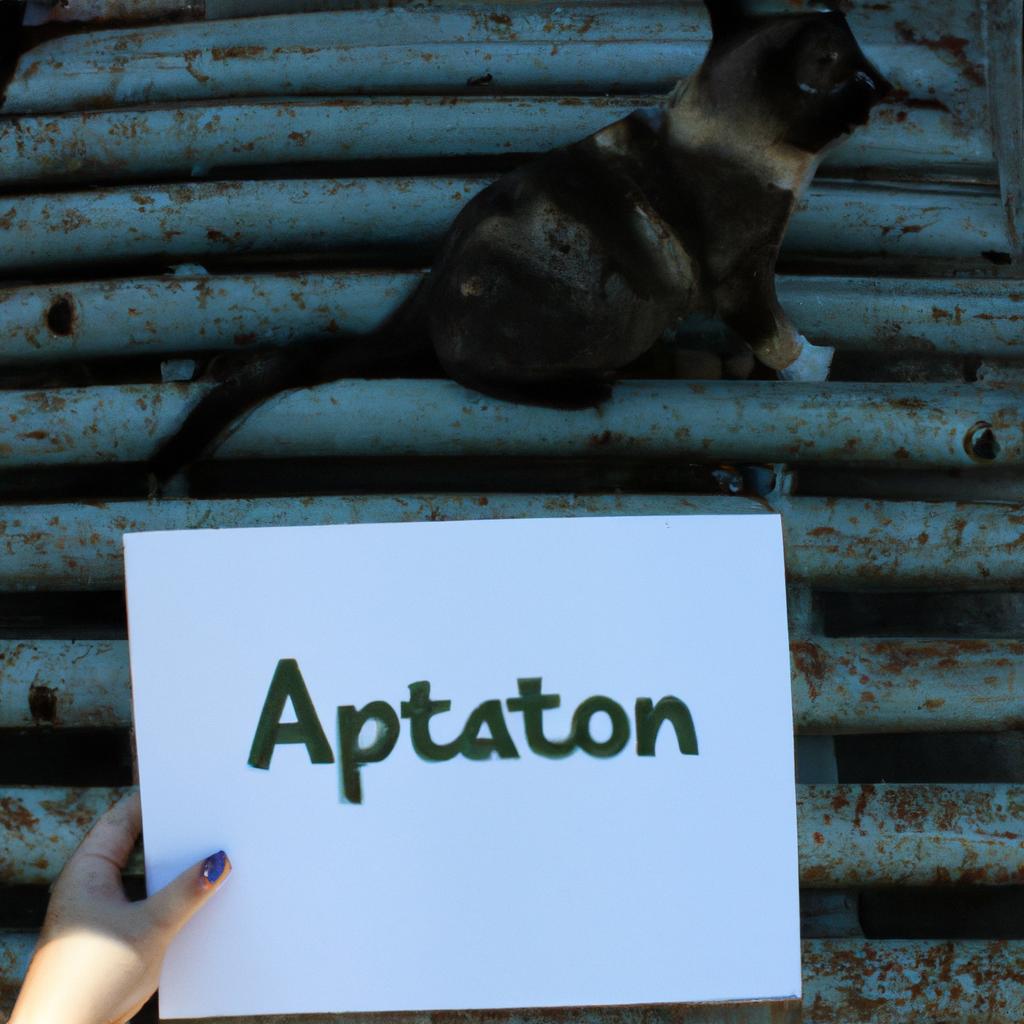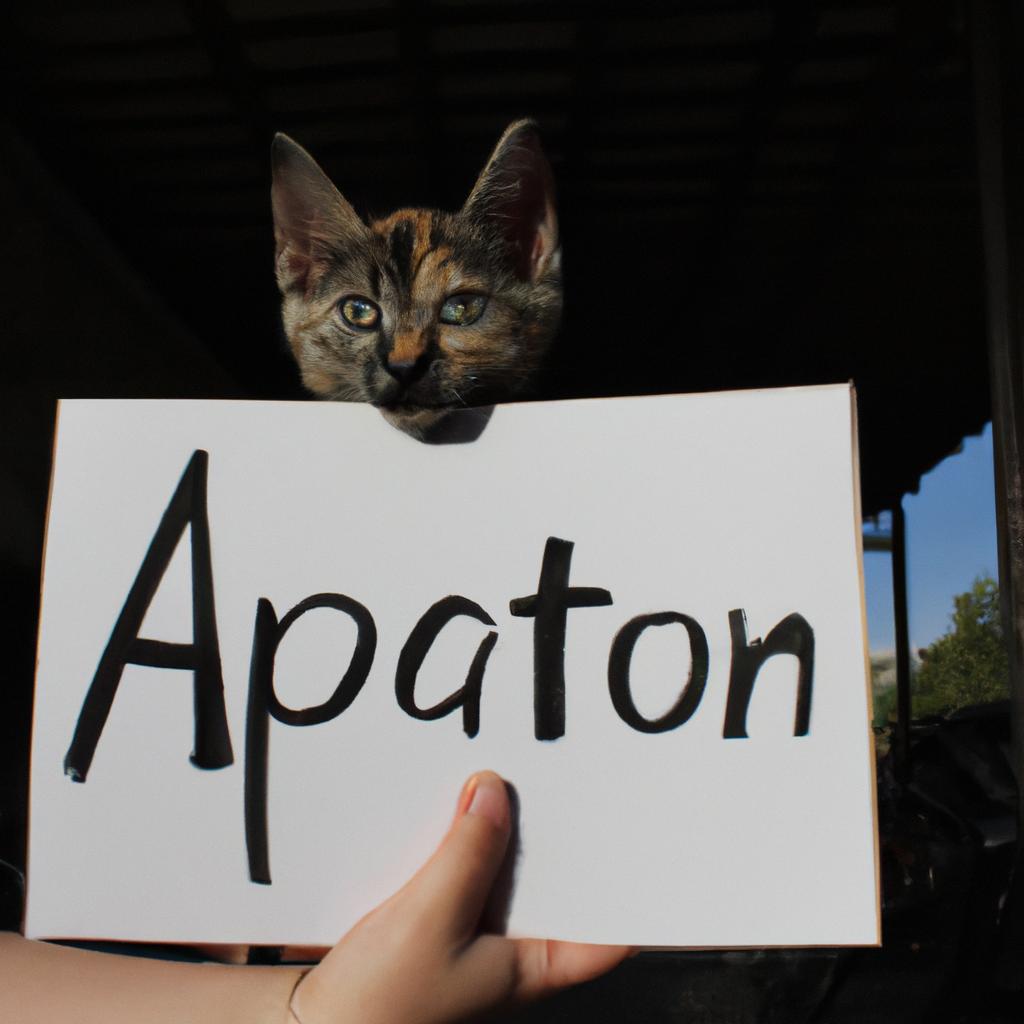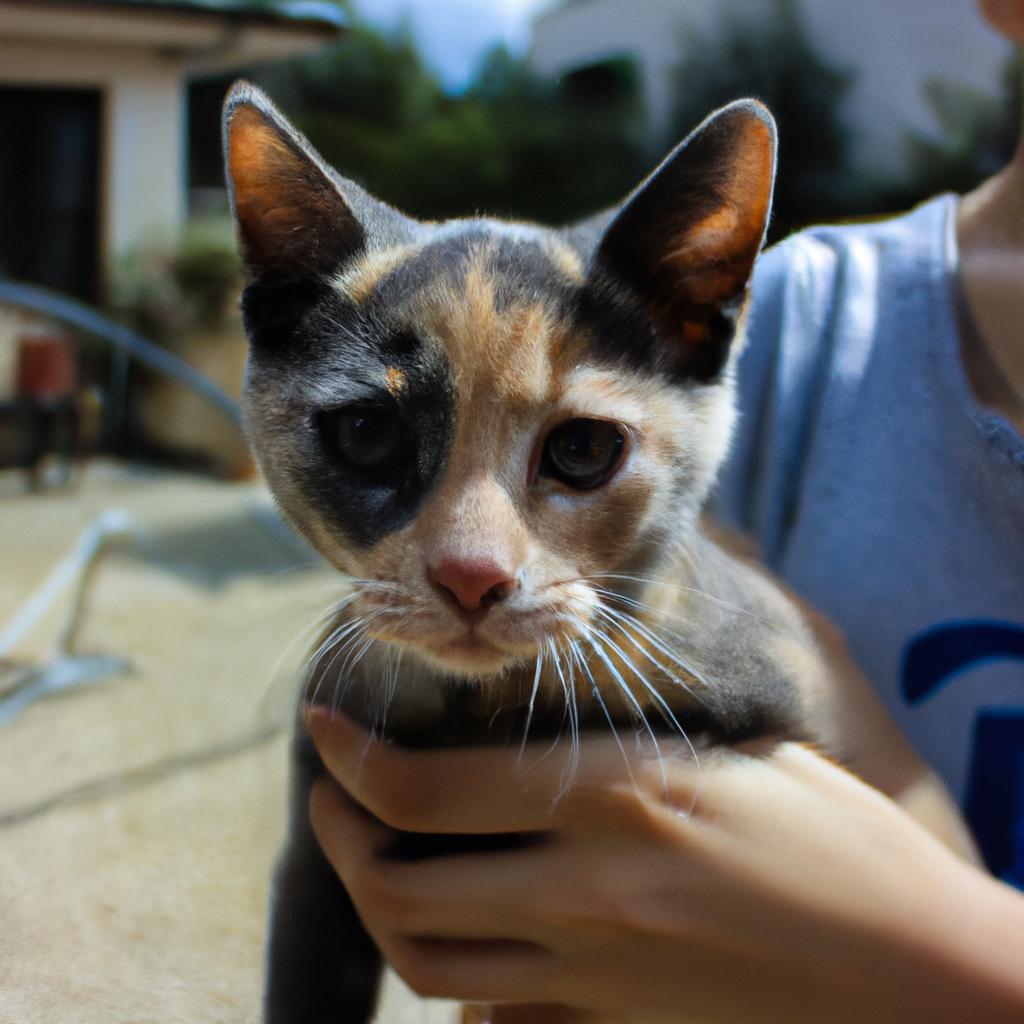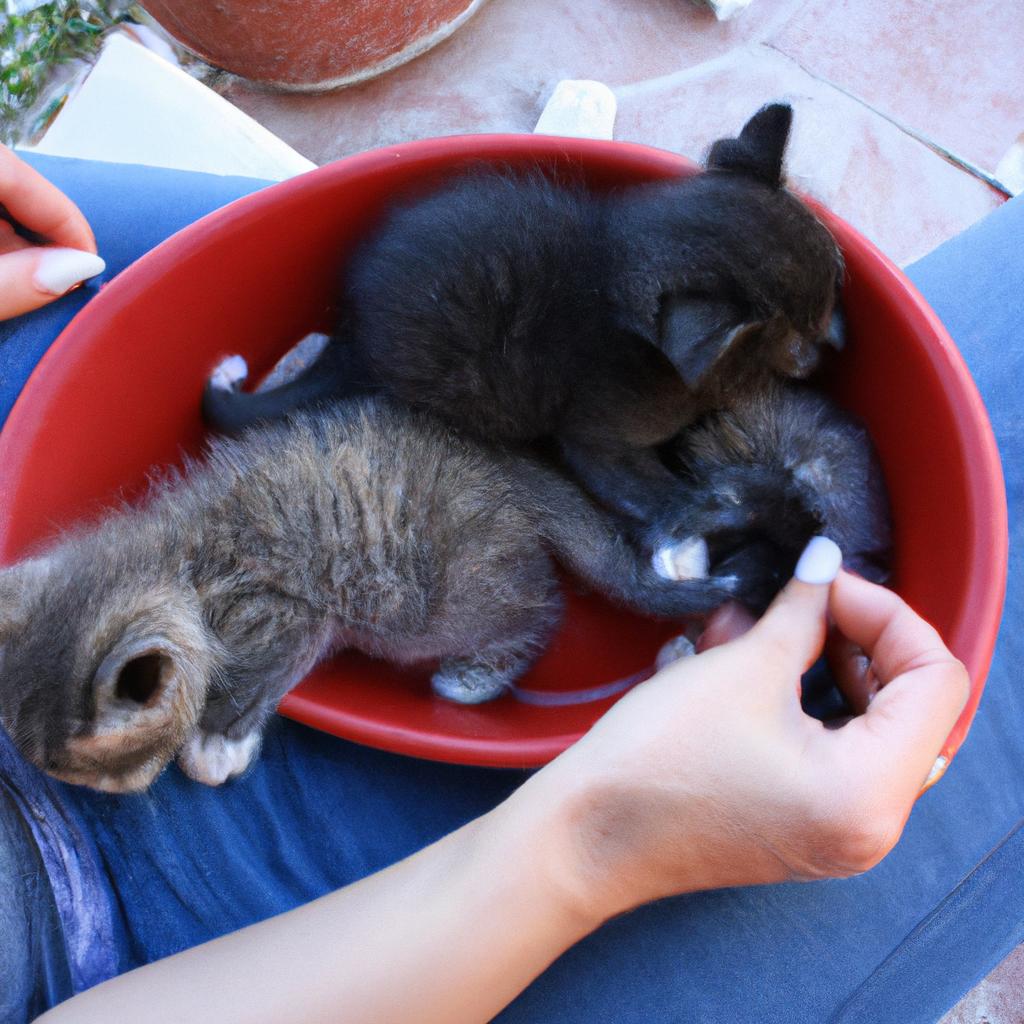The process of adopting a cat from a rescue foster care program is an intricate and crucial step towards providing abandoned felines with loving homes. This article aims to shed light on the adoption process within these programs, exploring the various stages involved in finding suitable forever homes for cats in need. To illustrate this process, let us consider the hypothetical case study of Luna, a stray kitten found wandering alone in a park.
Firstly, it is important to understand that cat rescue foster care programs play a vital role in ensuring the well-being and successful placement of cats into permanent homes. These programs typically involve dedicated individuals or organizations who provide temporary shelter and care for cats until they can be adopted. In Luna’s case, after being discovered by a concerned citizen, she was taken to a local rescue foster care program where she received immediate medical attention and necessary vaccinations.
Once Luna’s initial health needs were addressed, she entered what can be referred to as the assessment phase of her journey towards adoption. During this stage, trained volunteers conducted behavioral evaluations and assessments to determine Luna’s temperament and compatibility with potential adopters. Through careful observation and interaction with Luna, valuable insights were gathered about her personality traits, such as whether she would thrive best in a home without other pets or if she would be comfortable living with other cats or dogs.
Based on the information gathered during Luna’s assessment, the rescue foster care program began the process of matching her with suitable adopters. This involved considering factors such as the adopter’s lifestyle, previous experience with pets, and any specific requirements they may have had. The program also took into account Luna’s needs and preferences to ensure a successful and harmonious adoption.
Once potential adopters were identified, the rescue foster care program facilitated meet-and-greet sessions between Luna and these individuals or families. These meetings allowed for interactions and bonding opportunities to assess compatibility and determine if there was a mutual connection between Luna and the prospective adopters. It was crucial that both parties felt comfortable and confident in their decision to move forward with the adoption process.
If a strong bond was formed between Luna and an interested adopter, the next step was typically a home visit. This allowed representatives from the rescue foster care program to evaluate whether the adopter’s home environment was safe, suitable, and conducive to providing Luna with a loving forever home. They would check for potential hazards, verify that necessary supplies were available (such as litter boxes, scratching posts, etc.), and offer guidance on creating an enriching environment for Luna.
Assuming all went well during the home visit, finalizing the adoption required completing necessary paperwork and paying an adoption fee. This fee typically covers expenses related to veterinary care, vaccinations, spaying/neutering procedures, microchipping, and other costs associated with caring for Luna while she was in foster care.
After all formalities were completed, Luna officially became part of her new family. The rescue foster care program often provided post-adoption support by offering advice on cat care, behavior management tips, and access to resources for any ongoing needs or concerns that may arise. This support system aimed to ensure a smooth transition for both Luna and her adopters as they embarked on their new life together.
In conclusion, the process of adopting a cat from a rescue foster care program involves several stages, including assessment, matching with potential adopters, meet-and-greets, home visits, paperwork completion, and post-adoption support. Through these steps, cats like Luna are given the opportunity to find loving forever homes where they can thrive and be cherished as part of a family.
Benefits of Cat Rescue Adoption
Adoption Process: Cat Rescue Foster Care Programs
Benefits of Cat Rescue Adoption
Cat rescue adoption offers numerous benefits for both the adopter and the feline companion. To illustrate, imagine a family seeking to add a new member to their household. They come across a local cat rescue organization and decide to adopt an adult cat named Luna. This case study exemplifies the advantages of cat rescue adoption.
Firstly, by adopting a rescued cat, individuals contribute to reducing pet overpopulation in their community. Many cats end up in shelters or on the streets due to abandonment or neglect. By choosing adoption, families like the one mentioned above provide these cats with loving homes while also alleviating overcrowding in animal shelters.
Secondly, cat rescue adoption promotes responsible pet ownership. Adopters are often required to undergo screening processes that ensure they can provide proper care and attention to their new furry friend. Additionally, many rescue organizations offer guidance regarding nutrition, healthcare needs, and behavior management techniques. These resources help adopters understand how to meet their adopted cat’s specific needs effectively.
Moreover, adopting from a rescue organization often leads to healthier pets compared to purchasing from breeders or pet stores. Most reputable rescues conduct thorough medical examinations before placing animals up for adoption. Vaccinations, spaying/neutering procedures, and microchipping are commonly included as part of the adoption process. As a result, potential health issues are addressed early on, increasing the chances of long-term wellness.
To further emphasize the emotional impact of cat rescue adoptions, consider the following bullet points:
- Provide abandoned cats with a second chance at life.
- Experience unconditional love and companionship from your feline friend.
- Create lasting memories and forge deep connections with your adopted cat.
- Feel immense satisfaction knowing you have made a positive difference in an animal’s life.
In addition to these points highlighting the benefits of cat rescue adoptions, let us briefly explore them through the following table:
| Benefits of Cat Rescue Adoption |
|---|
| Reduces pet overpopulation |
| Promotes responsible pet ownership |
| Leads to healthier pets |
| Provides emotional fulfillment |
By opting for cat rescue adoption, individuals not only experience these benefits but also contribute positively to their community and animal welfare as a whole. In light of this discussion on the advantages of adopting rescued cats, let us now delve into the requirements for cat adoption.
(Note: Transition sentence) Moving forward, it is essential to understand the necessary steps and criteria involved in the process of adopting a cat from a rescue organization.
Requirements for Cat Adoption
After understanding the benefits of cat rescue adoption, it is essential to be aware of the requirements involved in the process. By meeting these criteria, potential adopters can ensure a smooth and successful transition for both themselves and their new feline companion.
To illustrate how these requirements work in practice, let’s consider a hypothetical scenario. Sarah, an animal lover, decides to adopt a rescued cat named Bella from her local animal shelter. As she embarks on this journey, Sarah must fulfill certain obligations to provide Bella with a safe and loving home.
Firstly, one crucial requirement is that potential adopters should have a stable living situation. This means having suitable accommodation where cats are allowed or obtaining written permission if living in rented property. Additionally, ensuring financial stability is necessary to cover expenses related to food, veterinary care, litter boxes, toys, and any unforeseen medical emergencies.
Secondly, it is vital for individuals looking to adopt a rescued cat to possess knowledge about responsible pet ownership. This includes understanding basic feline behavior and knowing how to properly handle and interact with cats. Furthermore, being willing and able to commit time and effort into providing proper care and attention is paramount for the well-being of the adopted cat.
Thirdly, prospective adopters need to demonstrate readiness for long-term commitment by considering factors such as their lifestyle and schedule. Cats require regular feeding schedules, playtime activities for mental stimulation, grooming needs like brushing or nail trimming sessions as well as affectionate interaction with their human caregivers.
Lastly, but equally important, adopting families should prioritize the safety of all members within their household including children and other pets when bringing a new cat into the environment. Introducing animals gradually under supervision helps build positive relationships between them while minimizing stressors during initial interactions.
In summary:
- Stable living situation: Suitable accommodation allowing cats or obtaining permission.
- Financial stability: Ability to cover expenses associated with owning a cat.
- Responsible pet ownership: Knowledge of feline behavior and commitment to proper care.
- Long-term commitment: Consideration for lifestyle, schedule, and safety of household members.
By meeting these requirements, potential adopters can ensure a smooth transition when bringing a rescued cat into their lives. Now, let’s delve into the crucial step of finding the right cat rescue organization that aligns with your adoption goals.
Finding the Right Cat Rescue Organization
Transitioning from the previous section on the requirements for cat adoption, let us now explore how to find the right cat rescue organization. To illustrate this process, consider the case of Jane, a passionate animal lover looking to adopt a feline companion.
When embarking on the search for a cat rescue organization, it is important to have some key considerations in mind. Firstly, individuals should prioritize finding an establishment that aligns with their values and goals when it comes to pet adoption. For example, Jane was particularly interested in supporting organizations that focus on rescuing cats from high-kill shelters.
Secondly, potential adopters should seek out organizations that provide comprehensive information about their available cats. This includes details such as age, medical history, temperament assessments, and any specific care needs or behavioral issues they may have. Jane found it helpful when she came across organizations that provided extensive profiles of each cat online.
Furthermore, it can be beneficial to choose a rescue group that offers support throughout the entire adoption journey. Some organizations go above and beyond by providing post-adoption counseling services or access to training resources for new pet owners. These additional provisions not only contribute to successful adoptions but also demonstrate the commitment of the organization towards ensuring positive outcomes for both cats and adopters alike.
To evoke empathy and understanding towards the plight of rescued cats and encourage compassionate action among readers, here are some points worth considering:
- Many rescued cats come from difficult backgrounds and require extra patience and understanding.
- Adopting a cat provides them with a second chance at life in a loving home.
- By adopting from a reputable rescue organization, you are actively contributing to reducing euthanasia rates in overcrowded shelters.
- The bond formed between humans and adopted animals often brings immeasurable joy into people’s lives.
To further engage readers emotionally while presenting relevant information concisely, we present below a table highlighting various aspects related to choosing the right cat rescue organization:
| Consideration | Example |
|---|---|
| Adoption fees and policies | Sliding scale fee based on income |
| Volunteer opportunities | Opportunities to foster or help with events |
| Community involvement | Collaborations with local businesses in fundraising efforts |
| Success stories | Testimonials from previous adopters |
As potential cat adopters explore their options, it is important for them to keep these considerations in mind. By choosing a rescue organization that aligns with their values and offers support throughout the process, individuals like Jane can find not only the right feline companion but also make a positive impact on the lives of rescued cats.
Transitioning into the subsequent section about the application process for cat adoption, it is essential to understand how this step plays a crucial role in ensuring successful matches between cats and prospective owners.
Application Process for Cat Adoption
Imagine you are a prospective cat adopter named Sarah, who is passionate about rescuing cats in need. Sarah is searching for a cat rescue organization that not only shares her commitment to animal welfare but also offers comprehensive foster care programs.
Paragraph 1:
When looking for the right cat rescue organization, there are several factors to consider. These include:
- Reputation: A trustworthy organization will have positive reviews and recommendations from other adopters or volunteers.
- Mission and Values: Ensure that their mission aligns with your own beliefs regarding animal welfare, treatment, and adoption practices.
- Adoption Process: Look for organizations that have clear guidelines and procedures in place to ensure successful adoptions.
- Foster Care Programs: If you are interested in fostering cats before adopting, seek out organizations that offer robust foster care programs.
Bullet point list (emotional response):
Consider these crucial aspects when selecting a cat rescue organization:
- Ethical Treatment: Choose an organization dedicated to providing humane treatment and compassionate care to all cats under their guardianship.
- Lifesaving Efforts: Support an organization committed to saving lives by rescuing cats from dangerous or neglectful situations.
- Rehabilitation Services: Opt for an organization that invests time and resources into rehabilitating cats with behavioral issues or medical conditions.
- Community Impact: Select a rescue group actively involved in community outreach initiatives such as education programs or spay/neuter campaigns.
Paragraph 2:
To further evaluate potential cat rescue organizations, it can be helpful to compare them using a table format:
| Organization Name | Reputation | Mission Alignment | Adoption Process | Foster Care Programs |
|---|---|---|---|---|
| Feline Friends Rescue | Excellent | Strong alignment | Simple and efficient | Comprehensive |
| Paws for Love | Positive | Moderate alignment | Thorough and detailed | Limited |
| Whiskers Wonderland | Mixed | Minimal alignment | Lengthy and complex | Basic |
Table (emotional response):
Compare these three cat rescue organizations based on key criteria:
Paragraph 3:
By carefully considering the factors outlined above, you can make an informed decision when selecting a cat rescue organization. Once you have found the right one, you will be ready to move forward with the application process for adopting a feline companion.
With your ideal cat rescue organization in mind, let us now explore the important steps involved in preparing your home for a new cat without causing unnecessary stress or discomfort.
Preparing Your Home for a New Cat
Once your cat adoption application has been approved, it’s time to move forward with the next steps in the process. One success story that highlights the impact of cat rescue foster care programs is the case of Bella, a sweet and affectionate tabby who found herself homeless after her owner passed away. Thanks to a local cat rescue organization’s foster care program, Bella was provided with a loving temporary home until she could find her forever family.
Paragraph 1:
To ensure a smooth transition for both you and your new feline companion, it’s important to prepare your home before bringing them in. This step not only helps create a safe environment but also allows the cat to adjust comfortably. Start by designating an area where they can retreat when feeling overwhelmed or anxious. Providing hiding spots such as cardboard boxes or cat trees can help make them feel secure during their initial adjustment period. Additionally, remove any potential hazards from the space, including toxic plants, loose wires, or small objects that could be swallowed.
- Set up food and water bowls in easily accessible locations.
- Create a comfortable sleeping area with cozy bedding.
- Provide scratching posts or boards to promote healthy scratching behavior.
- Place litter boxes in quiet areas away from high foot traffic.
| Item | Purpose | Example |
|---|---|---|
| Cat carrier | Essential for transportation and vet visits | Sturdy plastic carrier |
| Food and water dishes | To provide nourishment | Stainless steel bowls |
| Litter box | For proper elimination habits | Covered litter box |
| Toys | Encourage exercise and mental stimulation | Feather wand toy |
Paragraph 2:
Once your home is adequately prepared, it’s time to bring your new furry friend into their forever abode. Remember, each cat is unique and may require varying amounts of time to adapt to their new environment. Some may instantly explore and settle in, while others might take a bit longer to feel comfortable. Be patient with them during this adjustment period, providing plenty of love and reassurance.
As you eagerly await the arrival of your new feline companion, it’s important to familiarize yourself with the next step – bringing your cat home. This crucial stage sets the foundation for a harmonious relationship between you and your newfound furry family member.
Bringing Your New Cat Home
After preparing your home for a new cat, it is essential to understand the process of bringing them home. Let us now delve into the steps involved in adopting cats from rescue foster care programs.
Example: To illustrate this process, let’s consider the case of Sarah, who recently decided to adopt a cat named Bella from her local cat rescue organization. After completing the necessary paperwork and being approved as an adopter, Sarah eagerly awaited Bella’s arrival at her home.
Paragraph 1:
Bringing Your New Cat Home
The first step is scheduling a pick-up or delivery time with the rescue organization. Some organizations may require you to visit their facility to collect your new feline companion, while others offer transportation services directly to your doorstep. In Sarah’s case, she arranged for Bella to be brought straight to her residence by one of the dedicated volunteers from the rescue group.
Once Bella arrives at your home, it is crucial to provide her with a designated safe space where she can acclimate gradually. This room should contain all the essentials such as food and water bowls, litter box(es), bedding, toys, scratching posts, and hiding spots. By confining your new cat initially in a smaller area like this, you allow her to become familiar with her surroundings at her own pace before exploring further.
To make this transition easier for both you and your new furry friend:
- Maintain a calm environment during initial introductions.
- Gradually introduce other family members or pets over time.
- Provide plenty of positive reinforcement through treats and praise.
- Allow sufficient alone time for your cat to adjust when needed.
Paragraph 2:
Creating a Bond With Your New Cat
During those early days together, spending quality time bonding with your adopted cat plays an integral role in building trust and forming a strong connection. Engaging in interactive play sessions using toys that stimulate natural hunting instincts can help alleviate any stress or anxiety they might be experiencing. Additionally, establishing a consistent feeding and grooming routine will further enhance the bond between you and your new pet.
| Feeding | Grooming | Playtime |
|---|---|---|
| Provide high-quality cat food suitable for their age and health needs. | Regularly brush their coat to keep it clean and free from tangles. | Engage in interactive play sessions using toys that encourage exercise and mental stimulation. |
| Follow recommended portion sizes to maintain a healthy weight. | Trim their nails regularly to prevent overgrowth or scratching issues. | Rotate different types of toys to keep them entertained and engaged. |
| Offer fresh water at all times in clean bowls. | Monitor their dental health and consider regular teeth brushing if necessary. | Use wand toys or laser pointers for interactive play sessions together. |
Paragraph 3:
In summary, adopting a cat from rescue foster care programs involves bringing them home with careful consideration for their comfort during the transition period. By providing an appropriate space where they can adjust gradually, following these recommended steps, bonding with your new feline companion becomes easier while ensuring both physical and emotional well-being.
Please let me know if there’s anything else I can assist you with!




